Why does white bloom appear on grapes and how to process it?
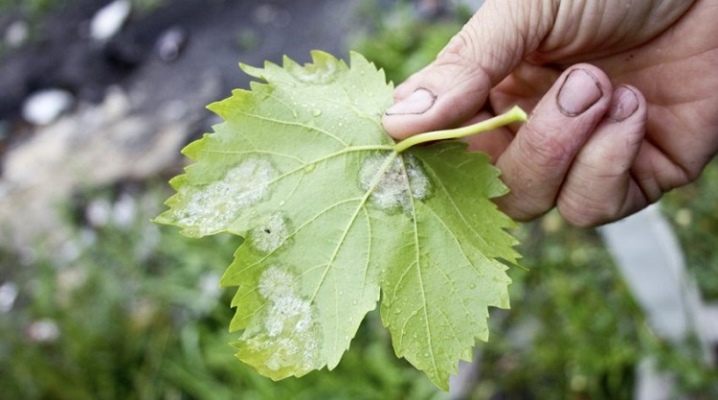
A seemingly harmless whitish bloom on grapes can eventually lead to the death of both the shrub itself and the crop. In order to avoid unpleasant consequences, it is important to start the fight against diseases in a timely manner and not to forget about preventive measures.
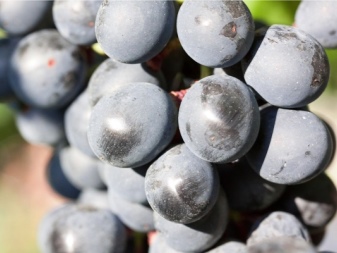
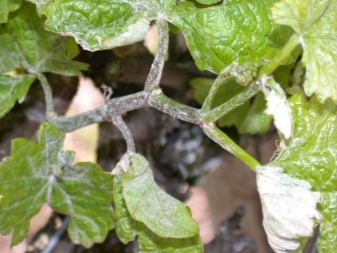
How to deal with mildew?
White bloom on grapes in most cases is mildew (downy mildew) - a fairly common grape disease. The action of the fungus first appears on the inner side of the plates, after which it "crawls" onto the shoots, inflorescences and ovaries. The appearance of a mildew to a novice gardener will be signaled by the presence of a grayish cannon on the leaves, which is especially noticeable in rainy weather, which turns brown over time. The fungus actively develops at temperatures from +20 to + 27 ° C, accompanied by high humidity and poor ventilation. The disease can "move" in several ways: in the wind, on the paws of insects, or at the expense of clothing and garden tools. Mildew hibernates in soil and under fallen leaves.
If you do not respond to the disease in a timely manner, then the grape bush may be so infected that it only remains to be destroyed. Oily, dirty yellow spots, with which the leaf blades are covered from the outside, gradually merge into a single formation, thereby affecting the entire surface. The leaf turns dark brown and then black, it dries up and falls off. The same fate awaits the bunches of berries: they turn blue, turn brown and, finally, dry up.
In order to diagnose the disease in a timely manner, it is necessary to regularly inspect the vineyard. If leaf blades with suspicious spots are found, they should be immediately torn off and placed on damp paper with the affected part. If it is mildew, then a whitish bloom will begin to appear on the back side after a while. It should be borne in mind that the incubation period of the disease begins at the moment the spores hit the surface and lasts until the appearance of oily formations.
As a rule, it lasts from 3 to 15 days. All parts of the plant, covered with a white bloom, are cut off with a sharply sharpened instrument treated with alcohol.
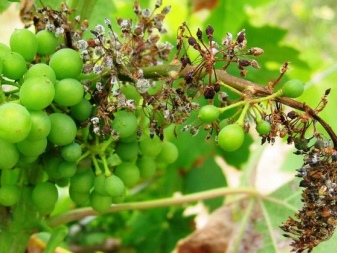

If the presence of mildew is confirmed, then the following should be done - immediately cut off all the affected parts, and then use contact fungicides. Most of all, copper-containing preparations are suitable for this purpose:
- bordeaux liquid;
- "Antrakol";
- "Ridomid";
- Thanos;
- "Cuproxat".
Since contact fungicides act only on the area that they cover, the surface of the leaves should be treated very carefully, paying special attention to their back side. Spraying with colloidal sulfur can be helpful. In order to prepare the solution, it will be necessary to dilute 80 grams of the product in 10 liters of water. The resulting amount should be enough to handle 60 square meters.
To prepare a sulfuric solution, you need to dilute 30 grams of sulfur in 10 liters of water. After mixing the components until smooth and filtering the resulting mixture, it will be necessary to pour the liquid into the spray bottle and use it to spray the leaves and bunches.
It is important that the temperature during the procedure exceeds +20 degrees so that the sulfur can evaporate. However, processing can only be carried out in cloudy weather to avoid burns.
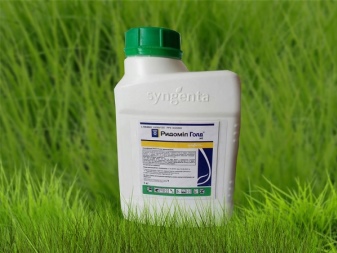

If the rotting of flowers and berries has already begun in the vineyard, then potent agents will have to be used, which are based on captafol, captan or folpet. On the contrary, at an early stage, you can try to get rid of white bloom with the help of folk methods.
- For example, a glass of peeled garlic cloves will need to be ground in a blender or meat grinder, and then poured with a liter of water. After mixing the contents, cover it and put it in a dark place for 24 hours. The finished solution is filtered, diluted with 5 liters of water and used for spraying bushes.
- You can also use a solution of potassium permanganate, for the preparation of which you will need to dilute 10 crystals in a liter of clean liquid. All aerial parts of the bush are treated with a pale pink solution, with special attention paid to the back of the leaf blades.
- Usually, wood ash can improve the situation. A kilogram of powder is diluted in a bucket of water. Having mixed everything thoroughly, it will be necessary to leave the solution for 5-6 days. Before processing, each liter of the ash solution must be diluted with 10 liters of water.
It is worth mentioning that in every folk remedy, it will be correct to add soap shavings, which allow you to keep the product on the surface for a long period. If most of the plant is affected, then it is better to destroy it by burning. The vacant space is necessarily disinfected, dug up and fed with mineral complexes. These activities should be carried out for a couple of years, and only then new crops should be planted on the updated fragment of the site. By the way, if one of the causes of the onset of the disease turned out to be high humidity, it will need to be reduced by removing the top layer of soil and replacing it with peat mixed with sand.


Other diseases
Symptoms similar to mildew, that is, a white bloom, also have mildew, alternaria and a number of other diseases.
Oidium
Oidium infects all parts of the plant, including leaves, stems and brushes. This disease is especially dangerous for inflorescences and young ovaries, although it can affect the entire aerial part of the grape bush, from the lower vines to the top. In the absence of timely treatment, the leaves begin to darken, dry out and crumble, and the flowers become covered with a grayish bloom, from which they turn yellow and fall off. The fact that the grapes have become infected with oidium is evidenced by the appearance of a plaque on the lower part of the leaves. If you wipe it off, you will immediately find specks of brown color. From above, the plate is covered with formations of white, gray or yellowish color.
The disease spreads rapidly throughout the bush. The green parts of the plant gradually turn black or dark brown. A mealy bloom appears on the fruits, which later transforms into dirty gray spots. The bunches cease to develop in size, and the grapes themselves turn brown and dry. With late infestation, the berries can also crack and rot. To save the vineyard from powdery mildew, it is necessary to immediately react to the specific smell of rotting fish.
A whitish bloom on any part of the bush should also alert. The culture should also be treated with contact fungicides:
- "Horus";
- "Topaz";
- "Tiovit";
- Strobe.
As a rule, a two-time treatment is enough to stop the spread of a fungal disease.
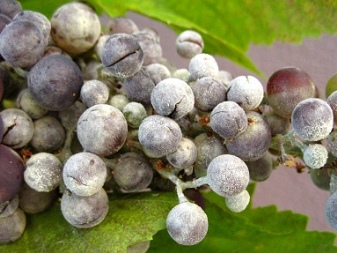
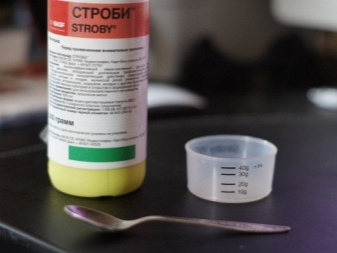
Alternaria
A symptom of vineyard disease with Alternaria is the silvered leaf blade. Gradually, the surface is covered with light yellow spots, which further rust and turn brown. The shoots of the bush dry out in the same way as the leaves. Further, the fungus moves to the trunk and berries. All this happens very quickly - in hot, humid weather, the grapes will die in 5 days.Moreover, if damaged berries, shriveled and covered with a metallic sheen, end up in the same basket with healthy fruits, the entire crop will be destroyed.
The culture infected with Alternaria should be sprayed with copper-containing agents. If the spores have time to penetrate into the tissues of the shrub, treatment with systemic drugs will be necessary, such as:
- Horus;
- "Quadris";
- Strobe.
In spring, it makes sense to spray the bushes with contact fungicides. We must not forget that when a disease occurs, all affected parts of the plant are immediately disposed of and, if possible, the top layer of the soil changes. The remaining specimens are treated with a 3% solution of Bordeaux liquid or copper sulfate.

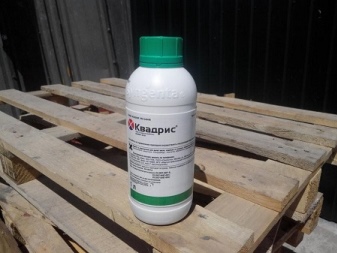
After 10 days, it makes sense to feed the grapes with drugs that include microorganisms, for example, such as "Emochka". To do this, 100 milliliters of the substance are diluted in 10 liters of liquid. After another 10 days, the culture is again processed with Bordeaux liquid or copper sulfate. A copper-soda solution has a good effect on the state of the vineyard, for the creation of which 50 grams of soda ash, 200 grams of soap shavings and 10 grams of copper sulfate, previously diluted in water, are combined.
If at first glance it is difficult to understand what exactly the plant has become infected with, it is worth starting with the implementation of universal "saving" measures. To restrain the multiplication of spores, it will be necessary to spray the grapes with a manganese solution every two weeks. In parallel, systemic drugs should be introduced, as well as the planting should be treated with a solution of humus. Sulfur-containing preparations always help to fight against white plaque. This is due to the fact that the sulfur absorbed by the fungi is transformed into hydrogen sulfide, which, in turn, negatively affects the mycelium. Bordeaux liquid will effectively cope with a weak whitish solution.
Young bushes can be sprayed with whey. Such processing is necessarily carried out under the sun's rays in order to activate the effect of milk protein. A solution is prepared from a portion of milk and three parts of water.
In all cases, it should not be forgotten that treatments with pesticides should be stopped three weeks before harvest.

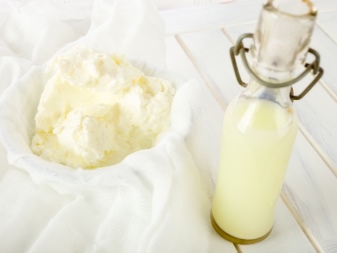
Prevention measures
In order to provide the necessary prevention of diseases on grapes, it is necessary to understand why, in general, the culture is affected by a white bloom. Fungal spores infect plants with weak immunity and mechanical damage. Often, those specimens that are attacked by all kinds of pests also suffer. The causes of the development of the disease can be improper care and inappropriate conditions. In the first case, the problem is caused by the lack of pruning, and hence the thickening, due to which the vines and dense foliage interfere with the penetration of air and light. The resulting increased humidity and stuffiness are ideal conditions for the spread of the disease. The same can be said about waterlogging of the soil.
In order to prevent the defeat of the bushes by various diseases, it is necessary to engage in prevention in time.
- The main preventive measures include cleaning procedures. It is important to free the site from fallen leaves, tops, plant debris and weeds.
- Of course, preventive spraying with potassium permanganate and sulfur solutions play an important role, which are held in early spring and autumn before wintering.
- Grapes need proper feeding: so, nitrogen is beneficial to the culture only at the beginning of the growing season, and then the plant already requires potassium and phosphorus. Sanitary pruning should be carried out at least twice a year, freeing the vineyard of excess stems, branches and green matter. Thinning should only be carried out using sterilized instruments. Watering the grapes requires regular but moderate watering.
- In order not to experience problems with grapes, the plant will have to pay due attention at the stage of acquiring seedlings. It is better to buy planting material in proven specialized stores, giving preference to healthy and well-developed samples.
When planting, it is important to keep sufficient space between individual bushes. You should also not place nearby crops that are subject to similar fungal diseases.
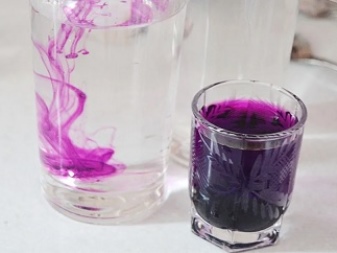
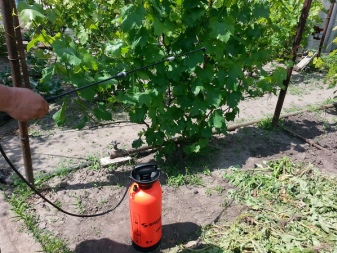
The next video will tell you about the remedies for powdery mildew on grapes.













The comment was sent successfully.